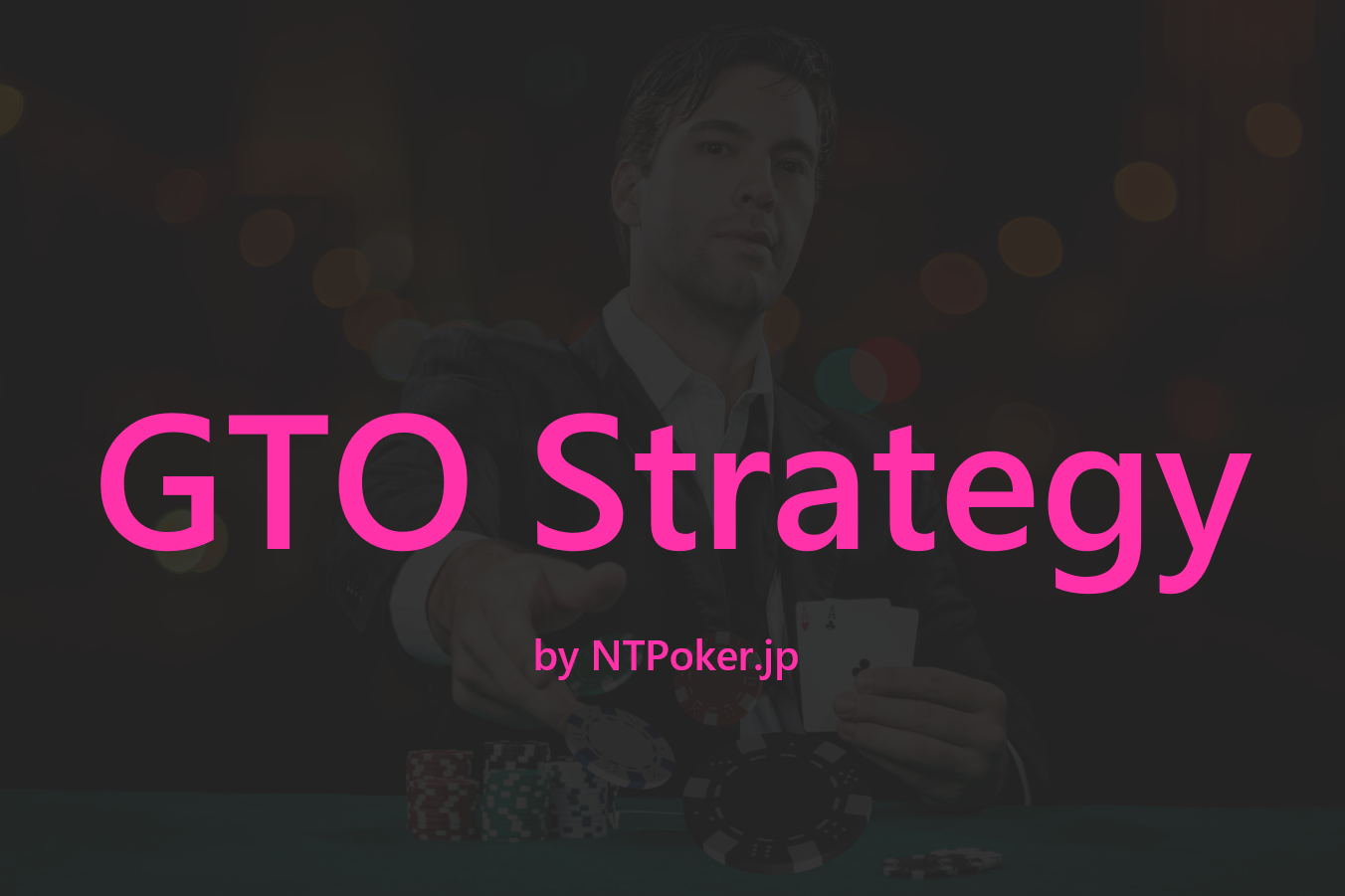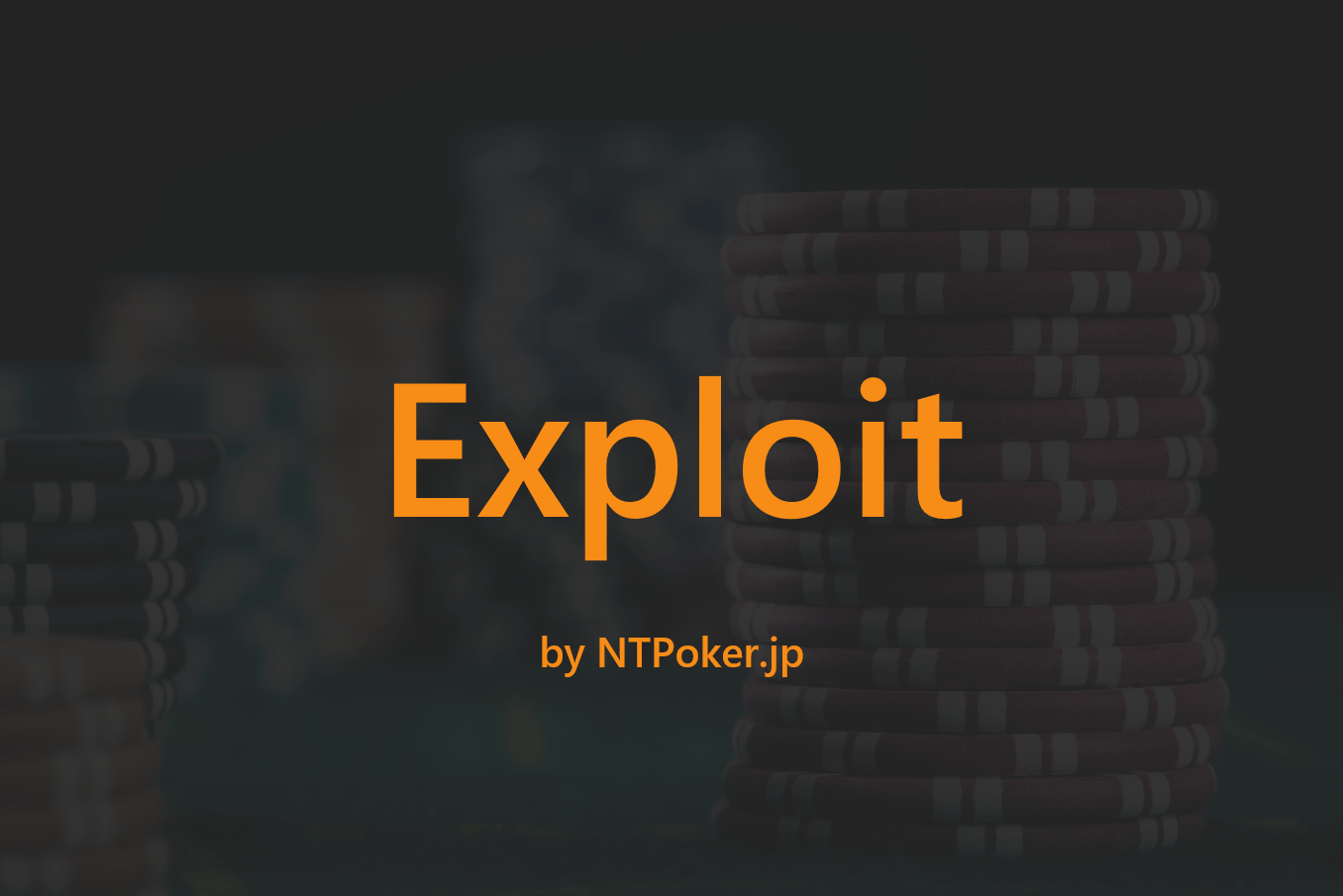Poker Learning Roadmap | NTPoker
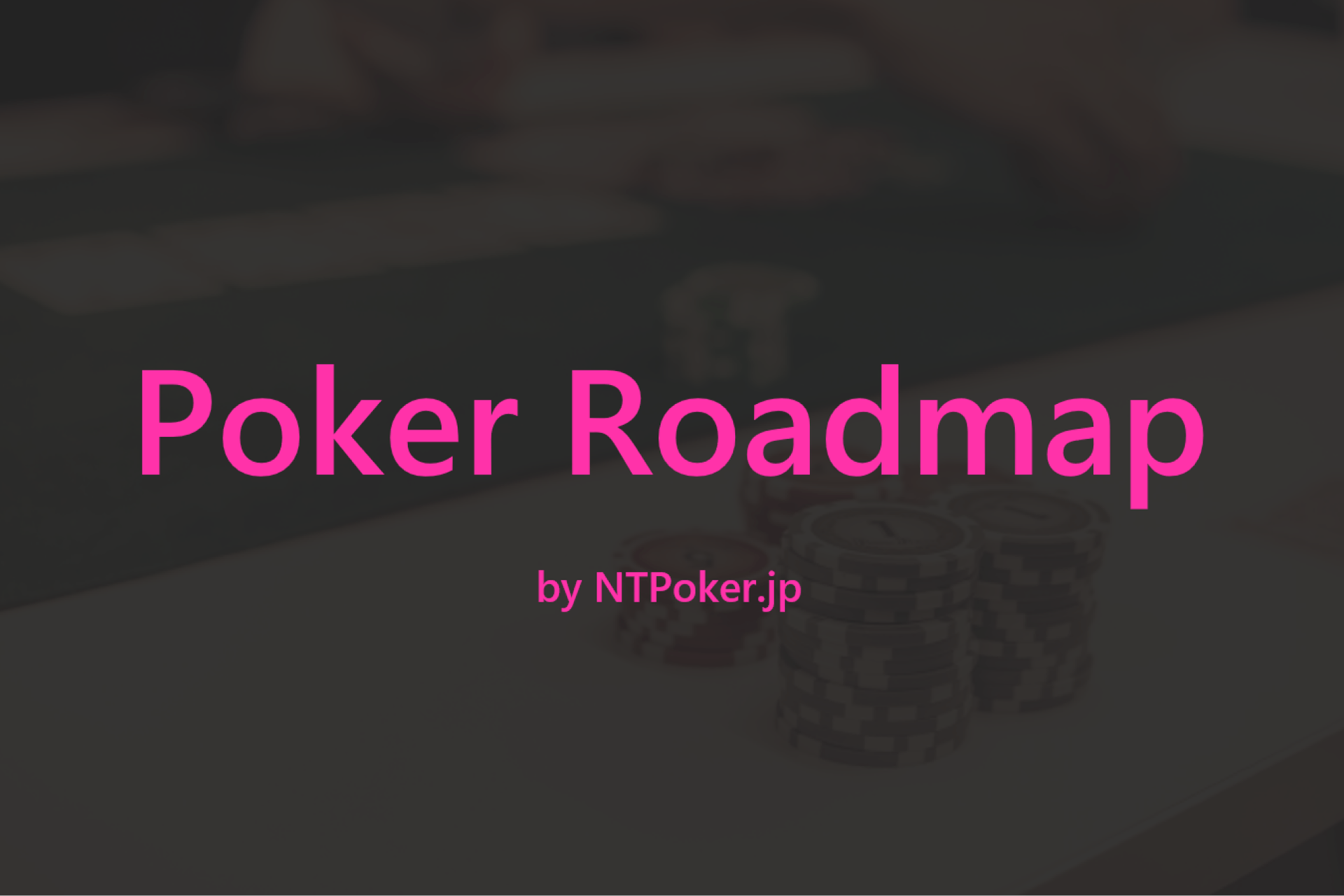
In this article, we’ll explain a comprehensive roadmap from beginner to professional level in poker, including the overall picture and specific actions to take at each stage.
Whether you’re just starting in poker, have reached a moderate level, or are aspiring for more, this roadmap is designed to be useful for players at various levels. We hope you find it helpful all the way through.
Table of Contents
Introduction

First and foremost, it’s important to understand that there is no magical method that makes everyone the best player in the world. If such a method existed, everyone would already be incredibly skilled at poker. Fundamentally, it’s about identifying what you lack, studying, and practicing repeatedly on your own.
However, there are “efficient” methods and roadmaps to improvement that have a certain degree of reproducibility. This article explains such a reproducible roadmap for improving at poker.
The key to getting better at poker involves a balanced approach to both “study” and “practice.” Focusing too much on theory can lead to being out of touch with practical play, while solely practicing can leave blind spots in understanding.
Additionally, it’s common to see players engaging in advanced concepts prematurely.
With these considerations in mind, this article will explain what to focus on, in what balance, and at which level.
Overall Learning Path
The overall learning path is as follows:
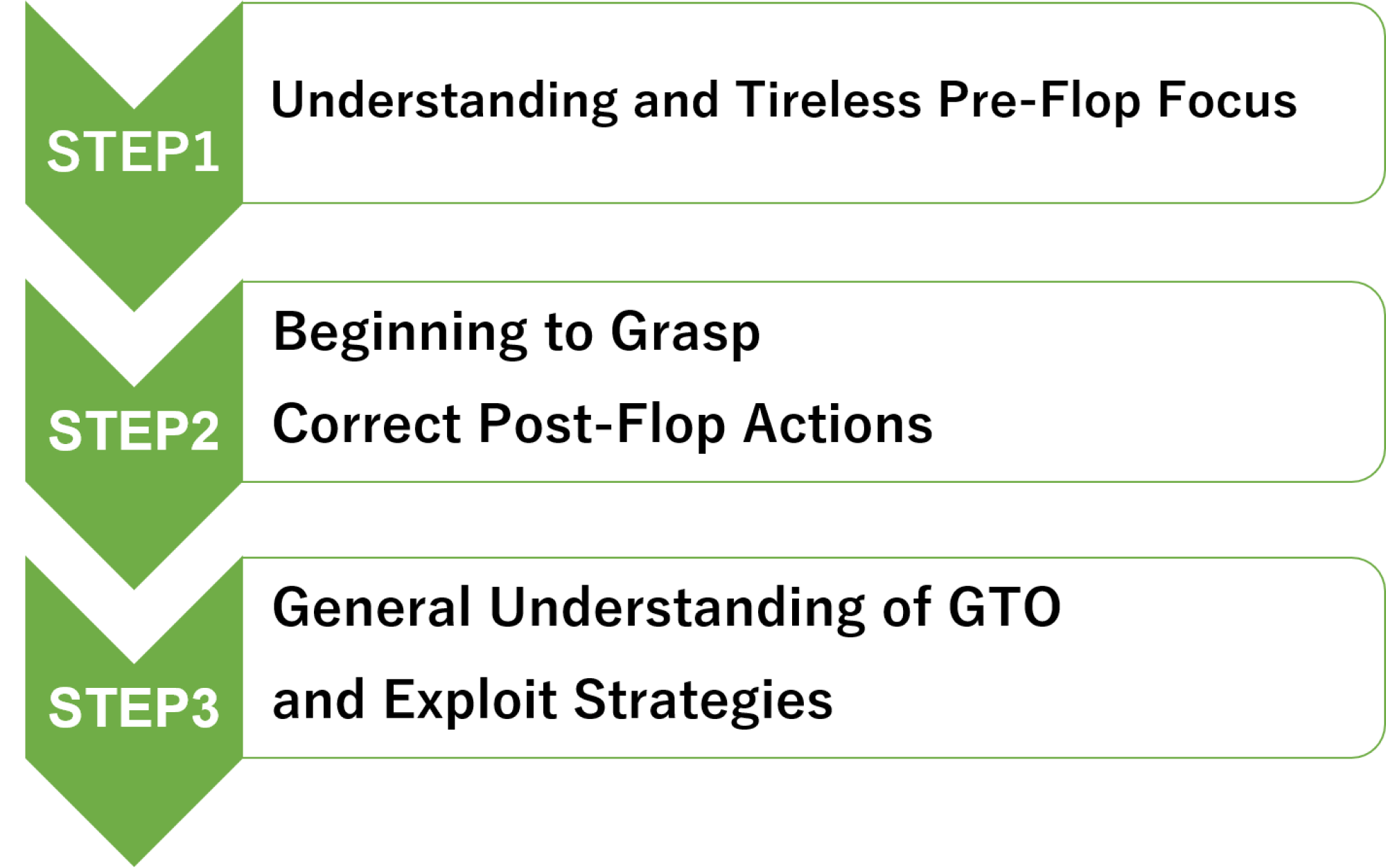
These stages are divided into
Beginner → Intermediate → Advanced.
If you’re unfamiliar with what GTO is, start here.
The image is as follows.
-
Beginner Level: Understand the rules and can enjoy playing with friends. This is similar to the level of progress up to the third badge in Pallet Town.
-
Intermediate Level: Rarely lose in amusement settings. Generally, play correctly according to the stats and start noticing the skill gap with more proficient players. This is like earning the fourth badge up to defeating the Elite Four and Champion.
-
Advanced Level: Capable of living as a professional in overseas casinos. Comparable to completing the Pokédex and producing numerous level 100 Pokémon.
In each of these levels, I will explain what aspects are important and what learning methods are most effective. Also, many poker players tend to overestimate their own level, so I recommend starting from one level below what you think you are at.
Beginner Level

General Rules of Poker
Understanding the general rules of poker is crucial.
This includes not only the specific rules (narrow sense) but also the common knowledge and practices among poker players.
To clear this level, you should understand and explain:
Specific Rules
Common Knowledge
Preflop Ranges
Memorize the preflop ranges thoroughly.
Since every game starts with the preflop, it has a significant impact on your overall performance.
[User Guide] Training An overview of training and how to use it.![[User Guide] Training](/static/b370356c45081537ac31e531a59a1f1b/bf515/header.png)
Intermediate Level

Intuitive Understanding of GTO Strategy
Once you’re comfortable with general poker rules and preflop strategies, the next step is to accumulate hands. This includes actual gameplay and hands in GTO training. The aim is to develop an intuitive sense of what actions are optimal according to GTO.
[User Guide] Training An overview of training and how to use it.![[User Guide] Training](/static/b370356c45081537ac31e531a59a1f1b/bf515/header.png)
Achieving over 75% accuracy in GTO-related actions signifies mastery at this level.

In GTO strategies, when there are options with different frequencies, choosing the less frequent option is not much of a problem. However, choosing an option with a 0% frequency will certainly lead to a loss in Expected Value (EV), so it’s important to avoid such mistakes.
For those who believe that they absolutely need to start with theory, it’s recommended to read the following articles or the book ’Modern Poker Theory - Contemporary Poker Theory’ before proceeding.
At this phase, in addition to GTO training, practical application is extremely important.
By doing both, you start to develop an understanding of GTO and begin to see how other players differ from GTO strategies. As this becomes somewhat clear, you start to develop an intuitive ability to exploit such differences.
Understanding Special Cases
In poker, there are various situations beyond the 100BB cash games, such as tournaments and deep stack games. It’s important to understand how these situations influence your actions.
Reaching this point, you are likely to rarely lose against amateurs or friends. In terms of golf, this would be akin to being in the early 80s.
Advanced Level

The advanced level encompasses a broad range of players, from those who are fairly competent to those who can live off poker professionally in international casinos. Therefore, it’s necessary to learn according to your own level. The following explanation will follow a typical learning process.
Strengthening Preflop Ranges
At this level, small mistakes begin to significantly impact your overall performance, necessitating further refinement of your preflop precision. You should aim to exceed a 95% cumulative rate in your training.
Moreover, a deep understanding of preflop range construction and adjustments based on various situations becomes essential.
Enhancing GTO Resolution
The next step is to evolve from having a ‘general idea’ of GTO actions to being able to explain ‘why’ those actions are optimal using universal concepts. To achieve this, improve your understanding in the following three areas:
Game Theory Understanding
GTO strategies, considered the most balanced in poker, are underpinned by game theory.
Understanding the background of game theory concepts like Nash Equilibrium and then learning GTO strategies will increase the resolution from theoretical backing to action decision-making. Therefore, learning game theory is essential for studying GTO.
Flop Set Analysis
In poker, the elements influencing action decisions are vast and considering all of them is extremely challenging. Therefore, analyzing which elements influence actions and how is a very effective method for enhancing the resolution of GTO strategies.
The board is one of the elements that determine actions, and there are 1755 combinations at the flop alone. As it�’s challenging to cover and respond to all combinations, we categorize them into patterns and understand the characteristics of actions. This is known as set analysis.
Especially in post-flop, where the number of experiences at the flop is the highest, being able to take the right actions at the flop is extremely important and has a significant impact on your performance.
Diving Deeper into GTO Strategy Interpretation
The next step involves a deeper interpretation of GTO actions, asking ’why’ they occur, and explaining them in specific detail, supported by higher resolution and theoretical backing, in addition to general concepts.
You will relentlessly analyze specific spots.
For each hand and situation, you analyze why a particular action is justified, and aim to reduce decisions based on ‘just a feeling’ to an absolute minimum, ensuring that every action can be logically justified.
Let’s consider a simple example.
Below is the GTO strategy for the BTN in a 2bet pot BB vs BTN on the flop.
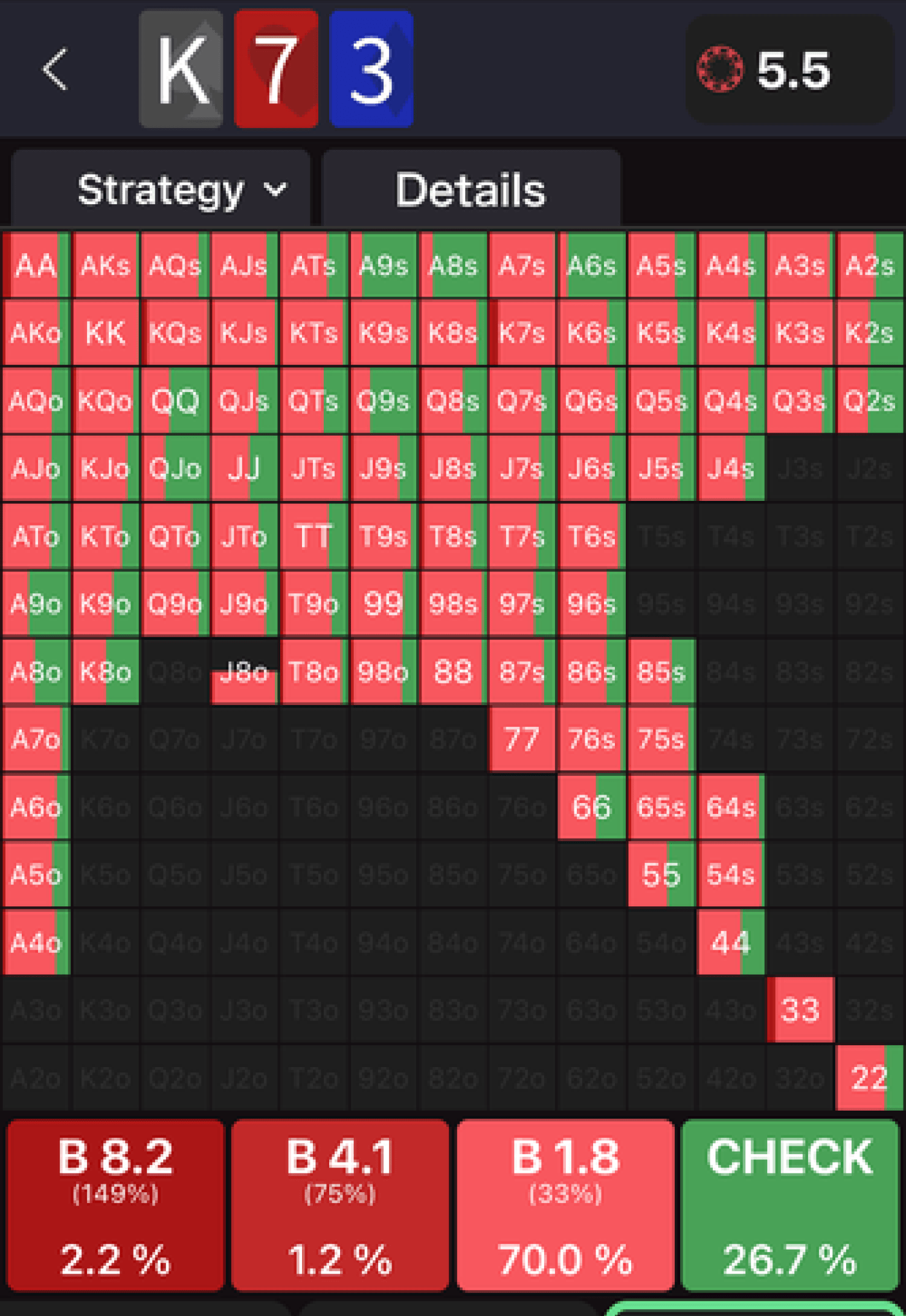
It is clear that the BTN bets with about 70% of its range, with most hands having the option to bet.
To understand why this strategy is effective, we focus on the following basic elements:
Considering the overall range EQ, the BTN has about 53% EQ and also has a nut advantage, suggesting a favorable situation. The combination of both ranges suggests that K high, dry boards are often favorable for the aggressor.
Focusing on the BTN’s range composition, it includes very strong hands, but also weaker hands like mere high cards.
Therefore, a strategy of betting frequently across the range is adopted to build the pot with strong hands and generate fold equity with weaker ones.
Mostly, a bet size of 33% of the pot is employed.
This seems to be a result of adjusting the bet size to maximize expected value across the range with high frequency betting.
Analyzing the relationship between range composition and EQ for each bet size can lead to a deeper understanding of specific reasons.
In conclusion, in situations where ‘the range contains a balanced mix of strong and weak hands, and overall has an advantage,’ it seems reasonable to interpret that ‘betting small and frequently across the entire range’ is an effective strategy.
It’s important to repeatedly interpret GTO strategies from different perspectives in various situations.
By refining interpretations and analyzing from multiple angles, the accuracy and resolution of your interpretations are enhanced.
This allows for the construction of more theoretically-grounded strategies in similar situations, meaning that as the accuracy and variety of interpretations improve, so does the precision and expected value of strategic construction in actual play.
Additionally, this deep understanding aids in recognizing situations where GTO strategies are not applicable, and is also very important in constructing exploit strategies.
Enhance the resolution of your GTO strategies from these three aspects, and aim to be able to decide your actions based on logical backing.
If you can broadly explain what hands are included in your range, which of them are for value, which are for bluffs, and how you balance actions across your entire range, then you can consider this step as cleared.
By reaching this level, your accuracy rate in post-flop training will likely exceed 90%.
GTO-Based Exploit Strategies
The serious study of exploit strategies begins at this level.Often in online articles, you may come across discussions contrasting GTO strategies with exploit strategies, but in reality, a deep understanding of GTO is essential for effective exploit play.
This is because exploit strategies fundamentally aim to extract more EV by leveraging an opponent’s ‘tendencies’, and you cannot effectively exploit these without a measure to gauge them. This measure is provided by GTO strategies.
To thoroughly learn exploit strategies, a solid understanding of GTO strategies is necessary and hence becomes relevant at this level.
Moreover, exploit strategies are highly case-specific, involving countless factors. Methodically learning each factor is inefficient, and it’s more effective to identify how an opponent deviates from GTO play.
The goal is to transition from an intuitive approach to exploit play to a more logical analysis of an opponent’s personality and play lines, enabling the application of appropriate exploit strategies.
For example, methods to understand an opponent’s deviation from GTO strategy include:
- Understanding Opponent’s Range Composition Tendencies
Players often have habits in how they construct their ranges. For instance, if an opponent’s check-raise range is overly value-heavy, or their BB raising range is too linear, deviating from theoretical values, exploiting these strategies can increase your EV.
- Identifying the Lower Limit of an Opponent’s Range
By considering hands shown at showdown and the situation, compare the opponent’s actual hand with their potential range according to GTO. Check if they are calling with hands that should barely fold or turning hands that should be raised into calls. Identifying these discrepancies helps grasp how they deviate from GTO.
By estimating opponents’ range construction and identifying the lower limits of their ranges, aim to be able to flexibly adjust your range accordingly. As you improve at this, you will begin to see GTO as just one of many decision-making factors, and from a wide range of information, make final actions to maximize EV. This approach is common among professional-level players.
In golf terms, this would be equivalent to playing even or under par—a level certainly sufficient for a professional career.
Conclusion

The content in this article is based on NTPoker’s independent research and interviews with various professional poker players. However, the path to improving your poker skills varies from person to person. Particularly, the content in the intermediate and advanced sections can be tackled simultaneously or in a different order depending on the individual.
Ultimately, thorough analysis, considering insights beyond human intuition, and rationally thinking for yourself, providing logical reasons for every action, is the surest shortcut to improvement in poker.


